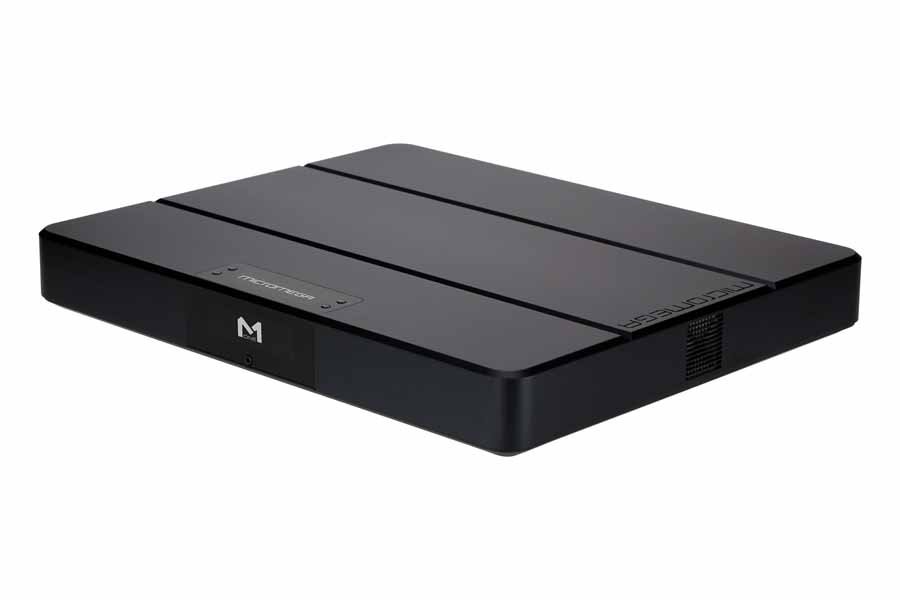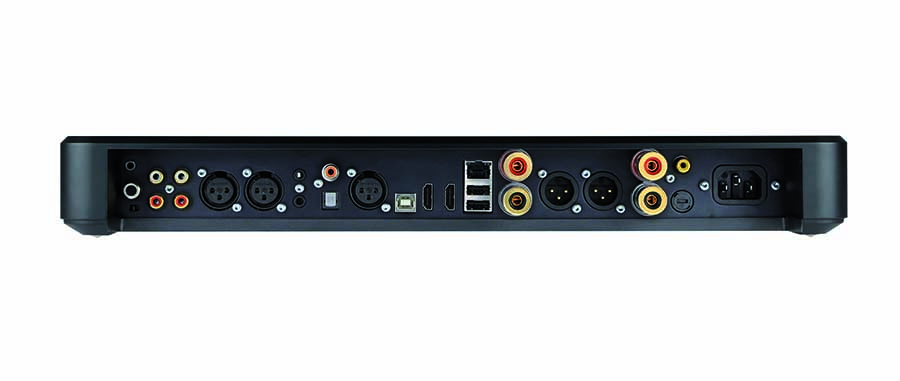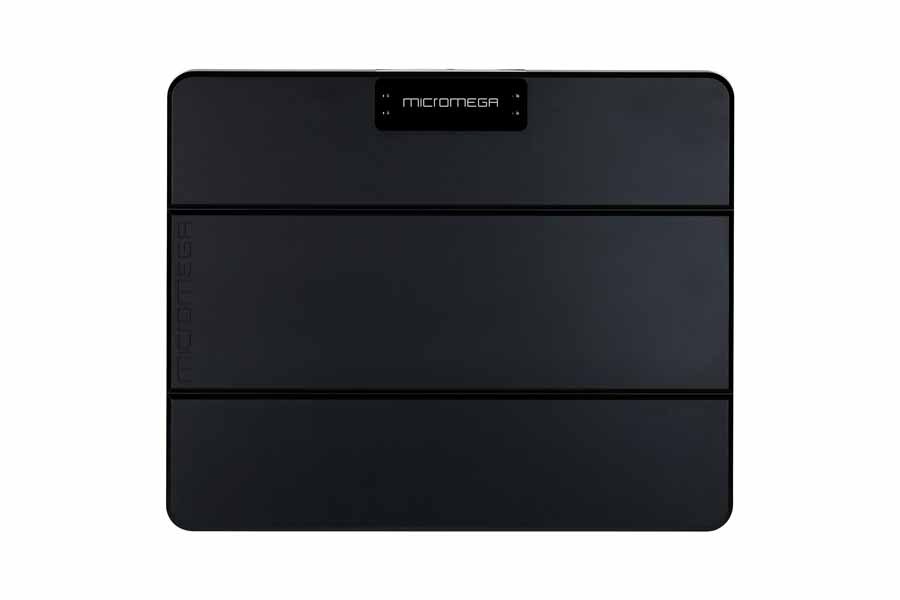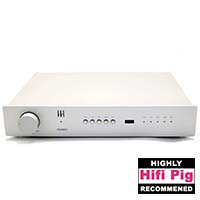In which John Scott confronts a philosophical pachyderm, feeds it a bun, pats it gently on its trunk and sends it on its way. Or John Scott takes delivery of the Micromega M150 Integrated amp/DAC/streamer costing £5499.
Let’s try a quick magic trick: Think of a French amplifier manufacturer. Have you got one in your head? Now think of a French amplifier manufacturer whose product can be placed on a shelf or hung on the wall. Does that change anything? Now think of the name of that manufacturer and the letter of the alphabet that it’s name begins with. It’s D, isn’t it? Thank you ladies and gentlemen and good night.
I hadn’t been aware of Micromega’s M series of amplifiers before I was asked to review them but as I read the marketing material, I couldn’t help but think that there were, at first glance at least, a number of obvious similarities between the M150, and it’s little brother the M100, and Devialet’s Expert series. Both have a similar form factor and footprint – more like a large laptop than a conventional amp. Both can be hung on the wall. Both incorporate a DAC and streaming technology. Both can utilise speaker-correcting software. When I took delivery of the M150, it seemed like an elephant had also slipped into the room; an elephant that sat balefully in the corner, silently willing me to make continuous comparisons between Micromega and Devialet. The M150 is distributed in the UK by SCV Distribution.
UNBOXING AND BUILD
The Micromega M15 arrived in a sturdy cardboard box inside of which was another sturdy cardboard box. Opening this revealed the M15 firmly snuggled within a polyurethane (I’m guessing) liner, keeping it safe from any bumps. The liner also held a remote control, power cord and microphone, lead and mini-tripod in separate boxes. A quick set up guide was also included with the full manual available online.
The case of the M150 is machined from a solid block of aluminium and as a result it feels satisfyingly solid. Two grooves cut across the width of the top face, dividing the top into thirds and adding a little bit of character. The amplifier has two LED displays: one on the top face and one on the front edge; this ensures that the display is easily visible regardless of whether the amplifier is wall or shelf mounted. Control of the M150’s functions is via 4 small buttons – one at each corner of the top face display.
At the rear of the amplifier is a comprehensive range of inputs along with a pair of high quality speaker terminals. The top surface of the amplifier overhangs at the rear which hides the inputs from view and makes connecting inputs and speakers slightly more tricky than it otherwise would be. Given the dimensions of the unit, space on the real panel is at a premium but the layout of the various inputs and outputs is logical and uncluttered.I placed the M150 on a soft towel on the floor in front of the shelf I wanted to place it on then tipped the unit onto its front edge so that the inputs were facing upwards. After I made the connections I was then able to place the M150 on the shelf.
While the elephant settled itself in the corner, I got on with setting the amp up, which was as straightforward as you would expect an integrated amp to be, once I’d got my head around the rear overhang. I expect that if you wanted to mount the M150 to the wall, this would add a level of complexity but I didn’t, so I can’t comment on that.
The M150 is available as standard in silver or black finish. I was supplied with the black version which I liked it a lot. It looked really classy, in an understated and elegant way, sitting on my shelf. Custom colours are available at additional cost so if you have ever wanted an amplifier in Hifi Pig Pink, the M150 could be just what you are looking for. Additionally, through a partnership with French loudspeaker company Focal, if you own a pair of Focal speakers your amp can be matched exactly to the colour of your speakers.
The M150 is supplied by a solid remote control that echoes the shape of the amplifier. The surface of this features 17 little buttons which control power/standby, volume, mute and Bluetooth connection. In addition, each input has its own button. This makes changing inputs straightforward but I might have preferred a less cluttered layout where one button cycled through the input options. Also, not all of the amps functions, for example balance, sensitivity and room equalisation, are controllable from the remote.
A BRIEF TECHNICAL INTERLUDE
First and foremost the M150 is, as the name implies, a 150 watt per channel amplifier (at 8 ohms). I mentioned earlier that the M150 is not only an integrated amplifier but also contains a DAC and a streamer. I’ve reviewed a couple of amp/DAC/streamer all-in-one boxes before and as good as they were, something about their design made me think that compromises were being made by bundling all three elements together. The design and build of the M150 seems to put the emphasis on this product very much as an audiophile integrated amplifier. Throughout the time I spent with it I found myself forgetting that it was actually carrying out DAC and streamer duties as well. This is a product that truly is integrated; integrating not only pre and power amplifier functions but everything that you need for digital playback. Your turntable hasn’t bee forgotten though, a phono input, switchable for both moving magnet and moving coil cartridges, is also included.
You would be forgiven for thinking that with a height of only 56mm, including clearance provided by spiked feet, the M150 must be a class D design. Class A/B amplifiers are big, thick, chunky things aren’t they? Well, not this one. A combination of dual power supplies – one per channel – and a cunning heat dispersion system allows a class A/B design to function efficiently in a smaller space. Heat is dissipated not only through the aluminium casing but also through a convection tunnel that runs across the width of the unit, drawing in air at one side and expelling with the aid of a magnetically levitating fan at the other. Any concerns I may have had about fan noise were quickly quashed; the fan is inaudible at all but the closest distance.
Streamer duties are handled by a downloadable app. The M150 can stream digital files from UPnP servers or via Bluetooth. Up to 32 bit resolution is supported at sampling frequencies up to 768KHz for PCM and 11.2 MHz for DSD. If you’ve read any of my previous streamer reviews you will know that I am particularly fussy about streamer apps – even more so since becoming a Roon user. Micromega’s app is not the most elegant I have seen but it is far from the worst and it does the job adequately as well as mimicking the functions of the supplied remote. I have to be honest though and say that for the majority of the review period I bypassed the M150’s streamer and used my Raspberry pi as a Roon endpoint into the M150’s USB input.
The Micromega Acoustic Room System (M.AR.S) is Micromega’s Room equalisation system which comes as standard on the M150 and is available as an extra on the M100. Micromega claim that M.A.R.S “…irons out any incidents in the amplitude/frequency response coming from reflections, absorption’s or resonances in the listening room [and] it also corrects imperfections in the speakers”.
I glanced over at the elephant. Maybe I was imagining it [You think? – Ed] but it was beginning to look a bit uneasy. Perhaps it could tell that I was quickly coming to the conclusion that comparisons between the M150 and any other French amplifier were really not necessary.
SOUND QUALITY
Time to get down to some listening. To begin with, I connected the M150 to my Linn Keilidhs, streaming from my NAS into the M150s LAN input and using the inbuilt streamer. Trust In Me from Bria Skonberg’s Bria album immediately impressed with robust but realistic upright bass, delicate percussion and vibraphone, and Bria’s smokey vocals and elegant trumpet. Spraying with female vocal, I moved on to The Jungle Line from Joni Mitchell’s The Hissing Of Summer Lawns, noting some extra grunt in the Moog bass and lots of detail in the Burundi background chants.
It was time to try out the M.A.R.S room equalisation system. This involves connecting the supplied microphone to the M150 and taking three readings of the full frequency sweeps that the M150 produces from the speakers – one reading from the centre listening position followed by one from around 20cm to the left and then 20cm to the right. Two equalised settings are then available – Auto and Flat. I replayed the same three tracks with the Auto setting engaged and found that the bass frequencies had been tightened up considerably. There was still oodles of bass but it seemed faster and more musical. On the other hand, the Flat setting took too much away from the music for my liking leaving it sounding exactly that – flat. Perhaps in other rooms it might come into its own but not in this room.
I swapped the Keilidhs out for my Audio GE Sincerus 80 floor standers. These are larger than the Keilidhs and front ported, and generally sound better in this room, with a more controlled bass. The same tracks were played again, with and without the room correction (the calibration measurements have to be redone whenever speakers are changed). As before, I preferred the corrected sound in the Auto mode although with the Sincerus 80s, there was less of a difference between the uncorrected and the corrected sound.
Finally, I hooked up a pair of Sonus Faber Sonatto II stand mounts that I had in for review. Yet again, the corrected sound was my preferred option and I suspected that the combination of the M150 and the Sonatto IIs really might be something special.
I looked the elephant squarely in the eye. It looked back, slightly sheepishly I thought. “Time to go?” I said. It nodded, packed its trunk (sorry, not sorry) and saw itself out. I wasn’t sure whether the absence of a philosophical construct would require me to re-run the room calibration but I did – just in case. The Sonatto’s stayed in for the remainder of the review period.
While I was satisfied with the M150’s streaming capabilities, I was missing the versatility of my Roon Nucleus+ streamer so I switched it in. I also wanted to see how the M150 shaped up purely as an amplifier so I bypassed its internal DAC and tried my Spectra portable USB DAC. At around £100 this couldn’t hope to compete with the Asahi Kasei AK 4900 “Velvet Sound” DAC chipset used by the M150 but the underlying qualities of the of the amplifier shone through and I found myself not in any particular hurry to swap it back out.
Finally, for headphone users there is a 3.5mm output on the front panel which uses binaural technology to provide an enhanced headphone listening experience. I don’t do a lot of headphone listening and it didn’t particularly encourage me to swap headphones for the Sonattos but if you are a headfi fan it might well float your boat.
CONCLUSION
Over the time I spent with the Micromega M150 its qualities shone through a variety of music from jazz to heavy rock to classical to electronic. It is not a cheap option but given that it is an all in one amplifier, DAC and streamer, I think it represents a solid investment that you would be unlikely to want to replace in a hurry so will give years of pleasure. Also you may find that the less powerful, and cheaper, M100 might meet your requirements. I was, however, so impressed with the M.A.R.S EQ system that I would definitely recommend adding that to the cheaper model.
My only real regret is that the M150 is not “Roon Ready”, and therefore requires a separate endpoint to enable it to work with Roon. I really think they have missed a trick here. Had it been Roon Ready, I’d have been setting booby traps up the garden path to prevent the courier from taking it away.
AT A GLANCE
Build Quality: Machined from a solid block of Alumunium and reassuringly solid feeling.
Sound Quality: Excellent and flexible with the on-board M.A.R.S speaker correction software.
Value For Money: Given it’s an amp and DAC (and a very good one too) this represents a solid investment.
Pros: Stylishly designed all in one audiophile unit. Effective room equalisation software. Plenty of power.
Cons: Idiosyncratic remote control (not a big deal though). Streamer app could be better. Not Roon Ready.
Price: £5499
John Scott
Manufacturer’s Specifications
Width : 430 mm
Depth : 350 mm
Height (with spikes) : 56 mm
Gross weight : 11 kg
Power Consumption
Standby : 1W
2 channels -1/8 Pmax under 8 Ohms : 185W
Rated output power
PRMS under 8 Ohms : 2x150W
PRMS under 4 Ohms : 2x300w
















































































































































































You must be logged in to leave a reply.